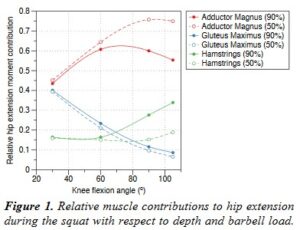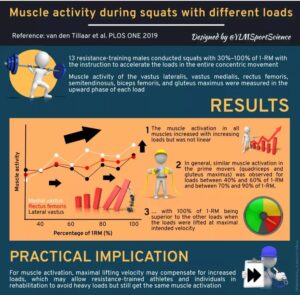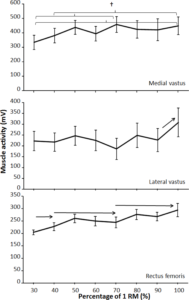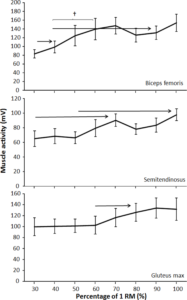2 LEG (BILATERAL) SQUATS – LOAD – RESEARCH
Click on Image to Enlarge
MOMENT ARM STUDIES
GLUTE MAX, AD-DUCTOR MAGNUS, QUADS, HAMSTRINGS
– Squat @50%RM and @90%RM with Knee Flexion Angles of 30º 60º 90º 105º
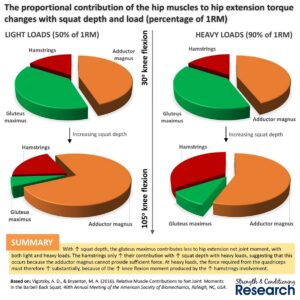 Relative Muscle Contributions to Net Joint Moments in the Barbell Back Squat – Vigotsky, Bryanton – 2016
Relative Muscle Contributions to Net Joint Moments in the Barbell Back Squat – Vigotsky, Bryanton – 2016
Procedure
– 10 resistance-trained women; squats using 50 and 90% 1RM
– estimated muscle moment contributions (gluteus maximus, adductor magnus, biceps femoris, semitendinosus, semimembranosus, rectus femoris, v. lateralis, v. medialis, v. intermedius, medial gastrocnemius, lateral gastrocnemius, and soleus)
Results
1. Gluteus Maximus – GM: in higher squat positions, the GM has similar contributions as the AM in generating a hip extension moment (Fig 1). However, the decreasing moment arm with increasing depth does not allow the GM to generate large hip extension moments in deep flexion; the relative moment contributions of the GM do not appear to differ substantially between 50 and 90% 1RM
2. Ad-ductor Magnus – AM: appears to play a pivotal role in hip extension during squats, producing, on average, >50% of net hip extension moment (Fig 1); this is most apparent in positions of greater squat depth and lighter loads. This is likely due to its larger hip extension moment arm in positions of greater hip flexion
3. Hamstrings: The Hams and AM appear to play a complementary role in hip extension; if the AM cannot produce a larger hip extension moment with increased load, the Hams increase their relative contribution in order to compensate (Fig 1)
4. Quadriceps: Increased role of Hams at the hip with greater loading has implications for Quads; a greater hip extension moment produced by the Hams necessarily means a greater knee flexion moment which must be countered by Quads to produce a sufficient net knee extension moment [3] (Fig 2)
– Rectus Femoris: it doesn’t appear to contribute to the knee extension moment in squats (Fig 2), likely due to its biarticular nature. The hip extensors may not be able to produce a large enough moment to overcome both external and internal hip flexion joint moments. In EMG studies the RM seems to be highly active [10]. However, the RM is highly susceptible to crosstalk from the Vastii [11] Fonseca [12] found the Vastii, not the RM, hypertrophied following a back squat-only program [12]
EMG STUDIES
GLUTE MAX, VASTUS LATERALIS & MEDIALIS, GASTROCNEMIUS
– 90º Knee Flexion Angle; Bodyweight 0%, 50%, 75%, 100%, 120%
Tibiofemoral Joint Kinetics during Squats with Increasing External Load – 2008 – Sahli
Procedure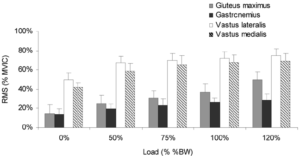
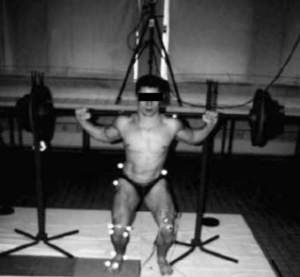
– 20 physical education students; previous experience in performing bb half squat ≥120% BW
– squat to 90° knee flexion; % bodyweight BW; 3 reps at each load
Electrodes
– Two electrodes were placed over each muscle belly with their centers 2 cm apart
Results – MVIC
Glute Maximus: 120%BW 50% | 100%BW 40%MVIC | 75%BW 30%MVIC | 50%BW 25MVIC | 0%BW 16%MVIC
Vastus Lateralis: 125%BW 75% | 100%BW 72%MVIC | 75%BW 70% MVIC | 50%BW 68%MVIC | 0%BW 50%MVIC
Vastus Medialis: 125%BW 70%MVIC | 100%BW 68%MVIC | 75%BW 64%MVIC | 50%BW 58%MVIC | 0%BW 42%MVIC
+ Gastrocnemius: 125%BW 28%MVIC | 100%BW 26%MVIC | 75%BW 24%MVIC | 50%BW 22%MVIC | 0%BW 15%MVIC
GLUTE MAX, RECTUS FEMORIS, VASTUS MEDIALIS, VASTUS LATERALIS
– 80º Knee Flexion Angle @30% of 6RM, 50% of 6RM, 80% of 6RM → 95%1RM+
Comparison of Muscle Activation during Free-Weight Back Squat Variations – 2019 – van den Tillaar, Andersen, Saeterbakken
Procedure
– 13 resistance-training males; squat to @80° knee flexion
– Warm-up:15 reps @30% 6RM, 10 reps @50% 6RM, 6 reps @80% 6RM
– Testing: load was increased to approx 95% 1-RM; load was then increased by 2.5–5.0 kg until failure; 1-RM was achieved within 2–4 attempts
– Each attempt was separated by a pause of 3–5 min
Results – Muscle Activity (MV)
Gluteus Maximus: 30% of 1RM = 100 → 100% of 1RM = 135
Rectus Femoris: 30% of 1RM = 200 → 100% of 1RM = 290
Vastus Lateralis: 30% of 1RM = 220 → 100% of 1RM = 300
Vastus Medialis: 30% of 1RM = 320 → 100% of 1RM = 420
+ Biceps Femoris: 30% of 1RM = 80 → 100% of 1RM = 140
+ Semitendinosus: 30% of 1RM = 65 → 100% of 1RM = 95
Conclusions
1. Our study corroborates results by McBride [4] who looked at vastus lateralis activation in squats using 70%, 80%, 90% 1-RM; participants were instructed to lift at maximal intended velocity; difference between 70% and 90% of 1-RM was only 1.3%
2. The rectus femoris has a bi-articular function as a hip flexor and knee extensor [39, 41] and may therefore be the first muscle to activate to stabilize the hip
3. In general, similar muscle activations in prime movers were observed for loads between 40% and 60% of 1-RM and between 70% and 90% of 1-RM, with 100% of 1-RM being superior to the other loads when the loads were lifted at maximal intended velocity. This means maximal lifting velocity may compensate for increased loads, which may allow resistance-trained athletes and those in rehabilitation (resistance-trained athletes) to avoid heavy loads but still get the same muscle activation.
